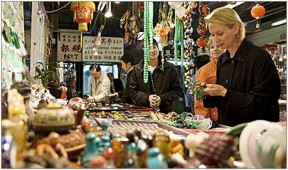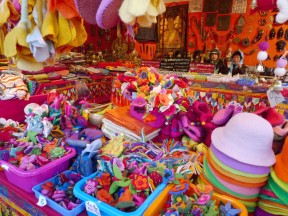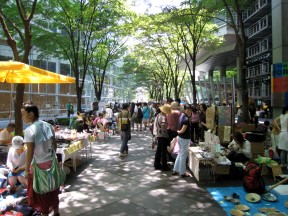The inspiration for this article comes from my love for street-shopping which to me is fascinating in many ways. First it combines my love for walking with shopping. You do have that option in malls but the local markets in a city have a different appeal, a liveliness in the banter of colors and words. Then of course, the latter is lighter on the pockets. I like the feeling of coming home with a bagful of goodies with my wallet still fat. It’s the retail therapy for the masses! Besides, there is so much to choose from– clothes, bags, shoes, jewellery, sunglasses, scarves, belts, crockery, books, lampshades, furniture, etc.
But there’s more to street shopping than just dirt cheap prices and wide variety. You know that a particular Louis Vuitton or Dior bag is famous when you see its fake counterpart on the streets. It’s a sad truth for the companies but had it not been for fakes, there wouldn’t be brand consciousness in the common folk; classic example of ‘imitation being the best form of flattery.’ There’s a high chance of people veering from fakes to originals and even if they don’t, they’re at least aware of the various brands. Apart from that, the streets carry the vibe of a city– a place is what is sold on its streets. Mumbai itself makes for an ideal example: there’s a marked difference between the shopping streets of Colaba, Dadar, Bandra, Vile Parle, Andheri, Borivali, as well as the crowd that’s throngs these streets.
Furthermore, whenever we travel– within the country or outside– the visit to a local market provides more cultural delight than any other touristy spot. Shanghai has the famous ‘fakes market’ that sells practically everything– watches, shoes, bags, clothes, perfumes; Paris’s flea market Les Puces (literally ‘the fleas’) promises a variety of antiques, paintings, old furniture, even missing parts from antique commodes; Thailand’s Chatuchak Market offers food, home décor and even pets.
Closer home, we have Goa’s Mapusa flea market that boasts the best bargains compared to all of Goa. Mumbai’s Kala Ghoda festival has craftsmen and artisans from all over the country participating in the large cauldron of culture through the shopping stalls. Jaipur is famous for its traditional minakari jewellery, chappals, and ethnic souvenirs while Hyderabad has a mind-boggling collection of beads and pearls. All the Tibetan markets in Sikkim, Ladakh, Dharamsala, etc. sell the most exquisite hand-crafted jewellery not to mention the prayer bells, inscriptions and paintings. There is no end to discovering a plethora of these cultural representations in the form of shopping items.
My travel experience has also proved that even the most unexpected of places would have something to offer in its shopping streets. Siliguri, the congested city of West Bengal has a ‘Hongkong Market’ that is a mix of everything from utensils, socks, clothes, jewelry, home appliances to even bicycle parts. As for me I’d bought a good amount of knick-knacks at literally throw away prices from this market. Similarly, in Laxmangadh,a remote village in Rajasthan, I was lucky to have spotted the perfect pair of bottle green sneakers for just Rs 350 (and they are still intact!).
The streets are where the action is; no wonder they are such crowd pullers. It would therefore be sinful to not include ‘local markets’ in every travel itinerary. Why else would Globe Trekker have separate episodes titled ‘Globe Shopper’?
Vidhi Salla is writer, blogger, movie buff and traveller. She writes movie reviews and also contributes informative travel articles to websites. She gave up a lucrative corporate career to pursue creative writing, that she strongly believes is her calling.









I could not resist but smile throughtout the article. 🙂
That is so sweet. Thanks 🙂
Very well written story. You should write more often on travelling.